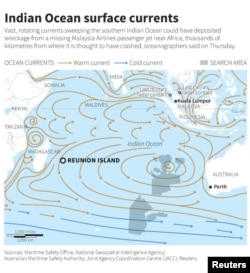A piece of plane debris that investigators believe might be part of the missing Malaysia Airlines flight that disappeared last year is being flown out of Reunion Island in the Indian Ocean, where it washed ashore.
The piece, believed to be part of a wing, is being flown to France, where a technical team will analyze it. The airline maker, Boeing, said Friday that it was also sending a team to France at the request of authorities to help study the plane debris.
Malaysia Airlines Flight MH370 was operating a Boeing 777 on the flight that disappeared in March 2014 with 239 people on board. Australian investigators said they are increasingly confident that the piece of plane debris is part of that missing jet.
Martin Dolan, chief commissioner of the Australian Transport Safety Bureau, told reporters Friday that authorities hoped to confirm the origin of the piece in the coming hours.
The 2-meter-long fragment, thought to be a wing component called a flaperon, was found Wednesday on a beach on Reunion Island, which is east of Madagascar and more than 3,500 kilometers (2,175 miles) from where the Boeing 777 was last tracked.
French investigators will try to determine if the numbers found on the object correspond with the missing jet. Experts have said they believe the results will be positive, based on the shape and the holes that connect it to other parts of the plane. Dolan said so far they have found no other case of a Boeing 777 losing a flaperon during a flight.
Ocean currents
MH370 mysteriously vanished en route from Kuala Lumpur to Beijing last year. Airline recovery expert Steve Saint Amour said he's not surprised at the distance between that route and the spot where the debris was found. Strong ocean currents in the middle of the Indian Ocean come up the Australian coast south to north, and near Port Hedland in Western Australia, they swerve west across the Indian Ocean and hit Madagascar, he said.
French aviation expert Xavier Tytelman has examined photos of the part and told VOA he is confident it belongs to a 777, the type of plane used for Flight MH370.
"We only found one match. It was with the flaperon of the Boeing 777," Tytleman told VOA via phone. "It was not only the shape that matched, but also the holes for the connections in it.”
Other search-and-rescue experts said the barnacles that grew on the debris should give a timeframe of how long the wing component had been in the sea and lying on the beach.
An underwater recovery expert said he expects more wreckage to be found and that experts will do reverse search calculations to get an indication of where the debris started from.
'Forensics' available
That single fragment may help clarify the fate of MH370, said one aviation safety expert.
There is "an amazing amount of forensics you can do" in studying one part, said Wayne Plucker, an aerospace expert with Frost and Sullivan, a consulting firm in San Antonio, Texas.
For instance, he told VOA, crash investigators look at the angle of the tears on the metal fabric and the rivets to determine the speed and angle of a plane before an accident.
Even the type of marine animals clinging to the wreckage can indicate if the fragment spent more time in cold water than in warm water, which will help guide searchers.
It is not implausible that wreckage from MH370 made its way to Reunion Island from the location where officials believe the plane went down, said Erik van Sebille, an oceanographer at Imperial College London.
Van Sebille, who studies how debris travels across the ocean, says that investigators may be able to use ocean currents and wind patterns to determine a rough location for the crash site.
'Not an easy task'
"It's not an easy task to do because over 17 months, the ocean is so chaotic and there is so much turbulence," Sebille told VOA. "If you start somewhere and you backtrack where the plane might have hit the water, you end up with an area that is probably a few hundred miles in diameter."
Such projections, however, would take a significant amount of time.
"Computers may be able to calculate ocean currents, time and distances to trace back a reasonable point of origin — if possible, this will take time — and then deep-sea searching must start all over again," said the aviation website Leeham News and Comment in a post late Wednesday.
The Malaysia Airlines flight, which was carrying 239 people, took off from Kuala Lumpur March 8, 2014, on its way to Beijing. It vanished from radar more than a hour later, somewhere over the South China Sea.
Malaysian investigators have said they believe someone deliberately turned off the plane's tracking devices and diverted the aircraft, but an investigation has turned up few clues.












